Deja Vu – A Plane Spotting Challenge by John Madden
Catch up on the previous reports from this challenge:
Introduction
Trip Report #1
Trip Report #2
Trip Report #3
*Trip Report #4
December 2020
Antigua
“A spotting trip that finally includes a flight!”
by John Madden
The Fourth spotting trip Report by John Madden on his epic aircraft by type spotting Challenge.
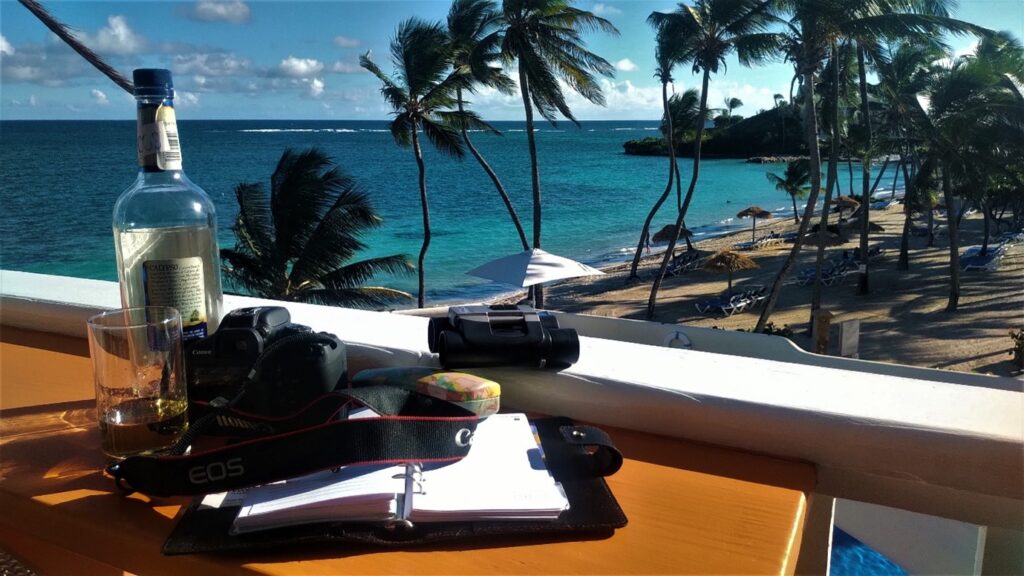
Ever since I embarked on this spotting Challenge back in February I have yearned for a trip that included flying somewhere, honestly anywhere would have sufficed. As chance has it a family holiday booked almost 12 months ago has come to my rescue and I do finally jet off for a bit of plane spotting. As many of us know (some all too personally), 2020 has not been without its challenges and this trip is no exception. Before departure day the trip had endured four flight cancellations, one change of hotel, one change of airline, one change of departing airport and just a week before departure a direct flight morphed in to a non-direct flight. Not that the latter bothers me as I am sure it wouldn’t bother you either, more aircraft to spot hopefully during the brief stopover. What does concern me a little are the reminders from my fellow travellers that we are going on a family holiday to enjoy the sun, sea, good food, quality time together and a few sunset Caribbean cocktails. Hopefully I can add a cocktail or two of my own that include a dash of plane-spotting, shaken not stirred of course.
Antigua may not be renowned as being one the World’s, never mind the Caribbean’s, busiest airports, but what I hope is that the small number of daily flights will provide a variety of airliner types that I can spot from our holiday resort just 9 miles south without losing too much family favour in the process. At some point on holiday we have all experienced “Spotting Deprivation Syndrome”; sitting by the pool smiling politely but totally cognisant of what we are missing at that really busy airport on the other side of the island. With the help of our trusted friend Flightradar24 and a well negotiated leave of absence from the resort, I should be able to manage to spot some colourful regional airliner delights and most importantly, remove a handful of aircraft types from the spotting challenge list.
So what am I expecting to spot in Antigua? When I say Antigua, I include VC Bird International Airport and anything else that passes over in view on its way to other Caribbean islands or Latin America to the south. One over flight that I am particularly keen to spot is the Conviasa Airbus A340-200 that often transits over or near to the island on en route from Caracas to Tehran; the series 200 is one aircraft type still to spot in my Challenge. Being an island and especially with the run up to Christmas I am also anticipating additional small parcel and tourist related aircraft movements. We will have to wait and see, but I do expect VC Bird International to provide the opportunity to spot a handful of Beech 99 Airliner, Swearingen Metro III, BN Islander, Shorts SD-360 and Embraer Brasilia aircraft, and if we are very lucky perhaps a Convair 440/580 that may drift in from San Juan just an hour’s flight away?
Sadly I don’t have my trusted wingman David with me on this trip, but my daughter’s boyfriend has shown considerable interest in my pre-holiday spotting plans and it looks promising that I will have an extra pair of eyes on hand. If his initial enthusiasm is anything to go by then he could be good for “turning”. My daughter would never forgive me but who wouldn’t want to take up spotting if we see some if not all of the aircraft types on my wish list? Whatever happens in Antigua, I am assured of one person that I can rely upon to share the local spotting delights with, and that is my old friend Captain Morgan.
Day Zero – London to Antigua:
London Heathrow:
It is many years since I last boarded a Caribbean-bound flight at Heathrow and this trip brings back fond memories of the colourful BWIA Airbus A340-300 aircraft the Madden family flew on when holidaying in Barbados during the early 2000s. Sadly the airline is no longer with us but there is a BWIA adorned Lockheed Tristar 500 sitting forlorn in Trinidad that I must spot before the humid Caribbean climate finally devours this special aeronautical beauty. From a selfish point of view the switch by Virgin from LGW to LHR for their Caribbean bound services is a very welcome one as we live only 15 minutes’ drive from the airport, and thank you Mr. Branson for adding Bridgetown to today’s schedule. When we left home for Terminal 2 our one stop outbound flight was aboard a Boeing 787-9 and the direct return flight aboard an Airbus A330-300, with a number of the fleet having just recently flown out of COVID-19 induced storage at Ciudad Real in Spain.
Not a great start to the day for a plane spotter, Heathrow is shrouded in fog and visibility is down to about 10 seat rows in length! Particularly guiling because a quick check on Flightradar24 reveals there is a Delta Boeing 767-400 on the ground, an aircraft type I still need to spot as part of this Challenge but today proving impossible to sight. I do hope this is not a sign of things to come on this trip? One aircraft nose I can see proudly poking out from the freezing fog as we stroll to the departure gate is Zurich bound Swissair Airbus A340-300 HB-JMC. What is evident today is just how few aircraft are actually using Heathrow, statistics show that movements are down around 70 percent year on year. I recently read that Paris CDG has over taken Heathrow as the world’s busiest international airport, not good? Another observation is the lack of four engine aircraft types on the ground, a story we are all too familiar with since the outbreak of Covid-19, but ironically the reason for the visiting Swissair Airbus A340-300.
Our steer for today’s journey to Antigua via Barbados is Boeing 787-9 G-VBOW “Pearly Queen”. I spent three years in East London during the early eighties and apart from becoming a temporary “Hammers” fan, it feels good to be in the company of a Pearly Queen again. This happens to be my first flight on a Dreamliner and I am intrigued to see how it stacks up against the Airbus A350. During the last 5 years or so when travelling long haul the more affordable off peak rotations all seemed to be the domain of 777s and A330s, with the Boeing 787 and Airbus A350 schedules assigned to the more expensive, conveniently timed choices. It would appear that these older models were already moving down the aeronautical food chain well before the recent global grounding of so many airline fleets due to COVID-19. I am looking forward to experiencing the large “dimmable” windows and lower flight altitude cabin pressure of the Dreamliner.
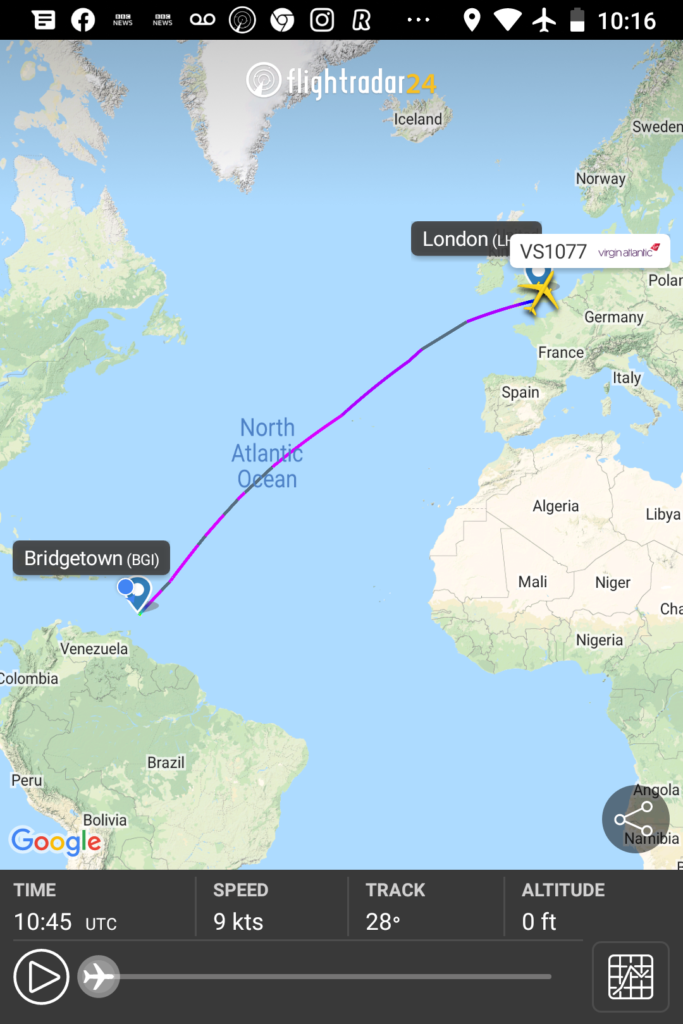
Barbados Grantley Adams Airport (BGI):
As per norm upon arrival in Barbados our aircraft lands from the west and departs the runway from the left and parks up towards the eastern end of the terminal on the northern ramp. The Barbados bound passengers appear to take an eternity to disembark and I await eagerly for the opportunity to explore what is on the ground. Due to new social distancing protocols introduced for the brief stopover it takes a few minutes to negotiate permission with the cabin crew to leave my seat. Once granted I am escorted to the forward door just behind the Upper Class section for a precious look at what is parked on the western end of the northern ramp. The local immigration officer who boarded the aircraft after arrival is suddenly attracted to what he believes is “suspicious” behaviour and I am quickly moved away from the open door. Thankfully I was able to hurriedly shoot a few photographs of the ramp albeit in competition with a very bright low lying sun to the west. On the ramp we have American Airlines Boeing 737-800 N836NN, Trans Caribbean Airlines ATR 72-600s 9Y-TTB and 9Y-TTC, interCaribbean Embraer 120 Brasilias VQ-TRG and VQ-TEG, Ameriflight Metro III N243DH, DHL Boeing 737-400 HI-3110 and an SVG DHC-6 Twin Otter J8-RAF. To the starboard of our Dreamliner is Boeing 737-400 ZS-OAT, a former Comair/ BA aircraft devoid of any titles and a recent arrival from Africa a few days earlier.
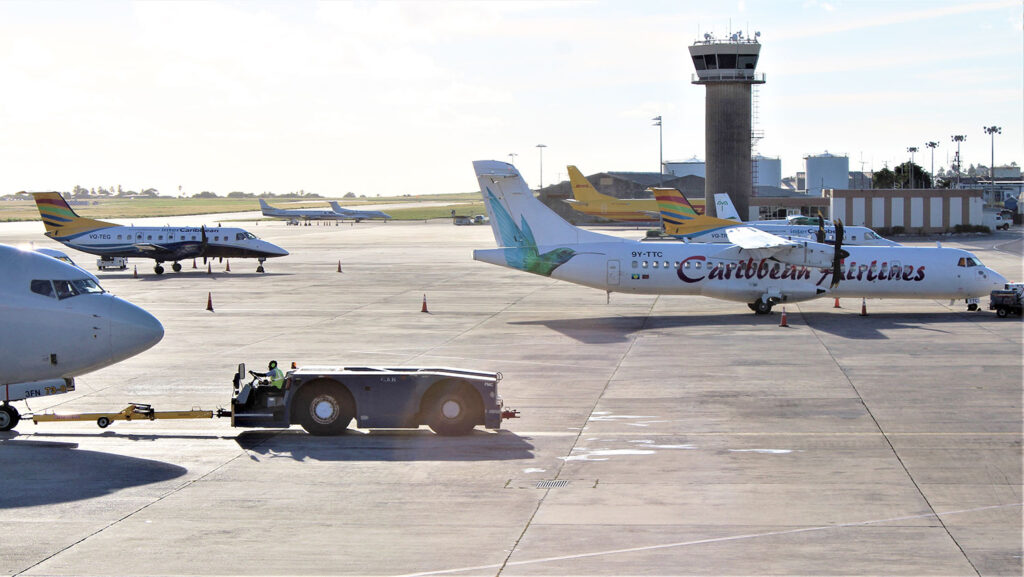
Bridgetown Barbados ramp scene.
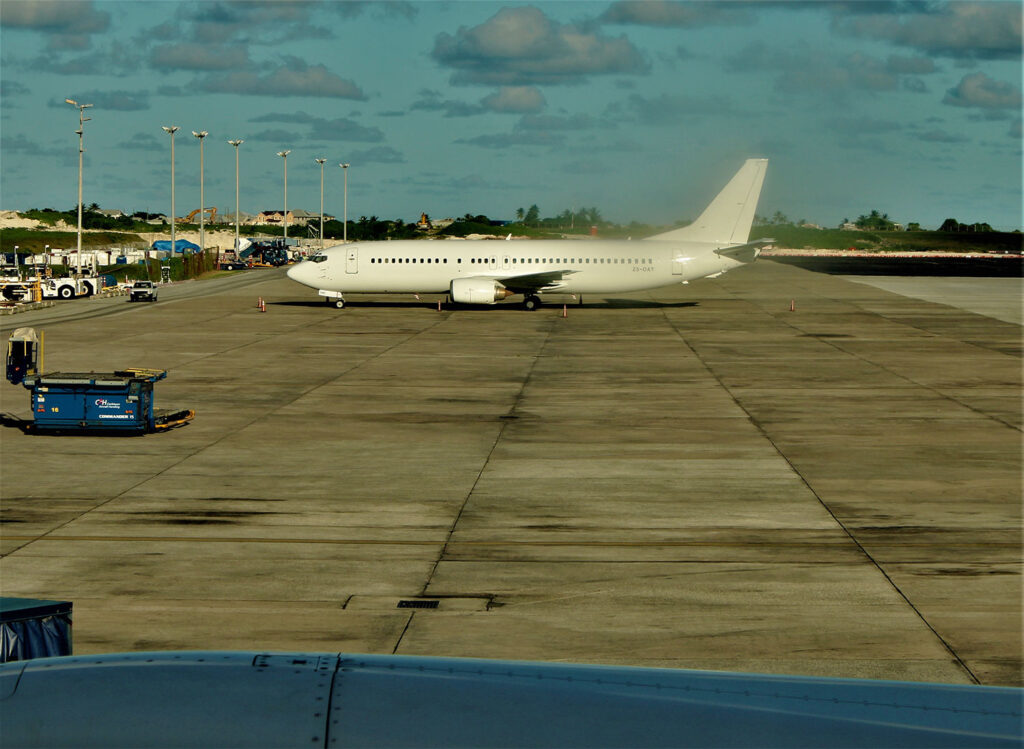
Boeing 737-400 ZS-OAT at Barbados.
I was most pleased to spot the pair of interCaribbean Embraer 120 Brasilias parked on the ramp. The aircraft has such a distinctive shape compared to other 30 seat regional aircraft of the era and brought back memories of the Air Exel aircraft I flew on several times in the late 1990s between Paris and Amsterdam. Whilst always full the aircraft never felt claustrophobic and I enjoyed those short flights immensely.
With binoculars at the ready and out of sight of the local officiana I retreat to an empty port side seat and focused my activity on the southern ramp. Any photographic opportunities would have to wait until take-off when we taxi past the hangars to the left of our aircraft. The southern ramp is home to a pair of resident Regional Security System (RSS) Fairchild C26A Metro III aircraft used for surveillance purposes throughout the region. Both aircraft were donated by the US Government to Barbados in lieu for allowing the US Military use of the airport when launching their invasion of neighbouring Grenada in 1989. Fortunately both hangar doors are open today and both RSS-A1 and RSS-A2 are at home and clearly visible along with Beech B99 Airliner J8-CRU of the now defunct Trans Island Air parked in the open.
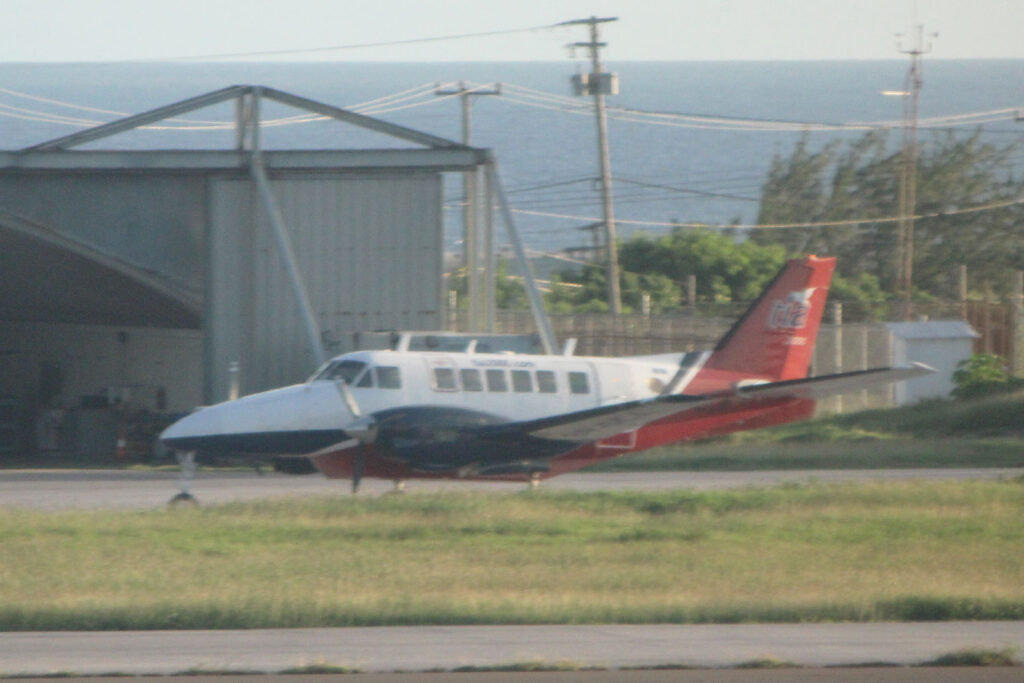
In the early 1960s this part of the airport was used by the US Army in support of the HARP Space Gun project led by the Canadian McGill University Space Research Institute. Unlike conventional rocket based launching techniques, HARP used very large field guns to fire projectiles into space at supersonic speeds. The University Research station constructed several such field guns and the largest with a length of 120 feet was capable of firing items as high at 80km, equivalent to the height reached for commercial space flights in the Virgin Galactica spacecraft.
When I first visited Barbados back in the 1990s I enquired about this project and the older generation would share their memories of frequently being woken up in the middle of the night by a sonic boom. The project came to an end in 1967 as both the Canadian University and US Army withdrew funding, the first largely due to domestic critics and the second due to its’ growing involvement in Vietnam. The guns used in support of the HARP project can still be visited just outside the southern perimeter fence on a site now used by Koncept Paint Ball, an apt use for this pioneering project I think you would agree? The brain child of the HARP Project was Canadian engineer Gerald Bull who later traversed the planet in search of a Government that would finance his concept of an artillery based satellite launch facility. He finally teamed up with the Iraqi Government to design and develop what Saddam Hussein named the “Supergun”. Before Project Babylon could be completed Mr Bull was found dead having been assassinated on his doorstep when returning to his then residence in Brussels.
On that sobering note let us return to VS186’s short stopover in Barbados. With the Barbados bound passengers disembarked and with a quickly spruced up interior we begin our taxi to the western end of the single runway and I am able to photograph the Beach B99 Airliner in front of one of the RSS hangers. To amuse ourselves during this short hop our group had engaged in a childish competition to win a bar of chocolate by guessing how many of the outbound 246 passengers had stayed aboard at Barbados for the onward flight to Antigua. The winner was my daughter’s boyfriend, I said earlier that he was showing promise and he had the nearest answer to the correct passenger count of 141 persons.

Antigua VC Bird International Airport:
The flight to Antigua took just 52 minutes at a sub 30,000 altitude and we landed in complete darkness, not that there was anything to see on the terminal ramp other than the silhouettes of several LIAT ATR aircraft parked in front of the company maintenance hangar. The biz-jet ramp located on the other side of the airport would have to wait until my planned visit to the airport on day three. Due to the newly introduced COVID-19 protocols at VC Bird International it took considerably longer than usual to transit through the airport and after 90 minutes we were in the taxi and off to our resort which was located approximately 9 miles due south at the eastern point of the island. It wasn’t long before I was reacquainted with my old friend Captain Morgan and contemplating what the next 10 day plane spotting might reveal.
Day One: 8.12.MMXX
Being day one I thought I would share the arrivals timetable so that you can develop a feel for the type of airlines and aircraft types using VC Bird International on a daily basis. In total 11 arrivals showing Beef Island (2 interCaribbean Embraer EMB120), Monserrat (2 FlyMonserrat BN Islander), San Juan (Mountain Air Cargo C208), New York (Jet Blue A320), Teterborough and West Palm Beach (4). As you can see it is a nice mix of scheduled airline and parcel carriers along with a healthy number of Biz-jets. Normally this time of year there would be several large airliners visiting from the UK but the pandemic has reduced this considerably to just three or four rotations per week. In addition to trying to be a family man on day one I have spent some time discretely working out which vantage points in and around the resort will offer views of arriving and departing aircraft. Fortuitously several appear to be located in one of the many bars. Being located in the south eastern corner of the island my only spotting black spot appears to be aircraft arriving from the north as they turn on to short finals. The following Flightradar24 image taken today illustrates the flight path used by departing aircraft heading south at an altitude of approximately 2,000 feet, in this case unscheduled DHL C208 Super Cargo Master on route to Dominica.
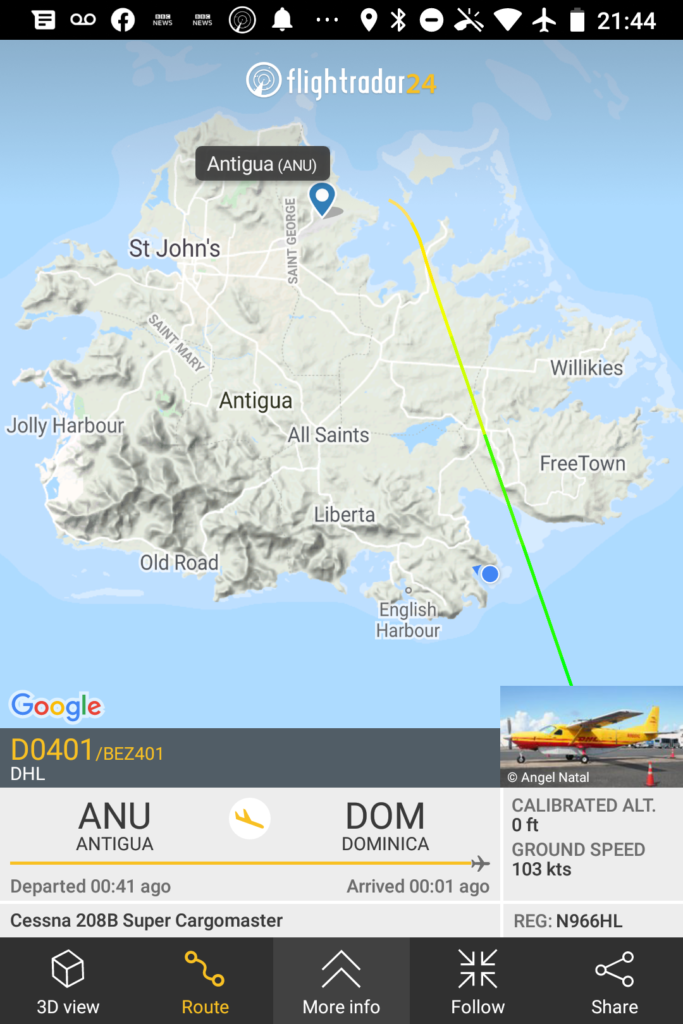
You will notice from many of the Flightradar24 images in this report that I don’t always have my phone with me when on the beach or out on the water so more often than not they will be taken anywhere up to an hour after having spotted the aircraft. At first I found this most frustrating but after a while it seemed to add to the hunt, if you know what I mean. On day one we already have an unscheduled departure. Thank you DHL, as the C208 Super Cargo Master was on my list of outstanding aircraft types to spot. I haven’t yet got my head around island overflights, I must focus more on this as I know there are plenty of choice aircraft in the vicinity that don’t visit Antigua.
Day Two: 9.12.MMXX
Flightradar24 shows that yesterday’s scheduled movements are largely repeated but today’s arrivals are boosted with an American Airlines B737-800 from Miami, a Tradewind Aviation Pilatus PC-12 from San Juan, an Ameriflight C99 from Sint Maarten and a Virgin Boeing 787-9 from London Heathrow. An interesting and unscheduled arrival to VC Bird that literally buzzed the resort in bound from Georgetown Guyana was Cessna 414A Chancellor N960DF of Air Services International.
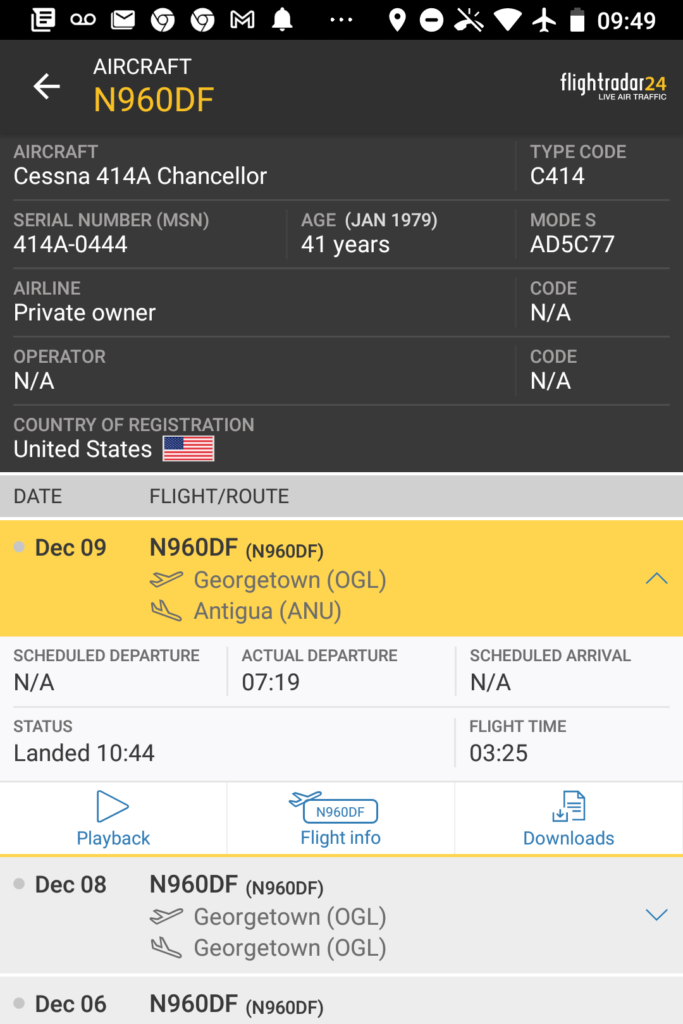
Day Three: A visit to VC Bird International Airport 10.12.MMXX
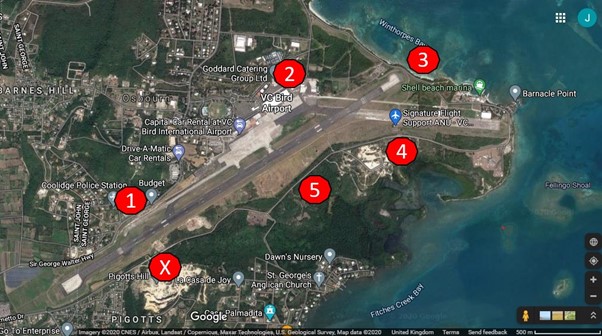
Today is the day when both beach and resort amenities will be traded for a half day plane spotting trip to VC Bird International Airport. The visit is not as long as I had hoped for but with an average of only 10 rotations per week day and long periods in between movements I selected Thursday morning as I had noticed in the run up to the holiday that an Amerijet Boeing 767 200 was an early morning visitor along with an interCaribbean Embraer 120 Brasilia and FlyMonserrat BN Islander. The lack of movements didn’t really concern me for several reasons. Firstly my brief stay on the island thus far has made it very clear that a number of unscheduled flights just arrive with little notice, secondly scheduled flights are often served with substitute aircraft types, and thirdly I expected the Biz-jet corner to reveal some very interesting aircraft. So the morning it had to be. Any hope of being accompanied by my daughter’s boyfriend evaporated pretty quickly at dinner the night before when without any previous discussion with her regarding the matter he naively stated that he was looking forward to going with me on my spotting trip. As a result I decided to hire a taxi for the 4 hour stint which incidentally paid dividends not only in having access to local knowledge, but it helped prevent a possible awkward moment which will be revealed later.
Located in the north east corner of the island and close to the capital St Johns, this is Antigua’s sole airport and has a single 9,967 feet long runway laid out in a south west to north east direction. The airport was originally built by the US Government as a USAF base in 1941 but transitioned into civilian use in 1949 after the US vacated the facility. The US did return, however, in the early 1960s not with aircraft but in the guise of what was known as the Antigua Air Station. This was a purpose built facility used by the USAF to track both friendly and non-friendly satellite and ICBM test operations and remained active until the mission was moved to Australia in 2015, a move motivated in response to a new perceived threat from the east? In addition to being close to Cuba, I am convinced the Station would have had more than a passing interest in the HARP Space Gun Project activities located just 400 miles south in Barbados. Like many other Caribbean islands in recent years, Antigua has taken advantage of generous cheap loans from the Chinese Government and opened the airport’s new terminal and facilities in 2015.
With each “new” airport comes the claim that it will soon be the preferred Caribbean hub, a claim that none have actually realised. I would have liked to visit San Juan for a day’s spotting but despite being located only 250 miles away it was impossible to travel there and back on the same day. I am aware that flight schedules have been affected by COVID-19, but affordable day round trips between the larger islands has been a historical issue despite the massive recent investment in airport infrastructure. Having said that though, VC Bird like all of the major Caribbean airports does a good job of providing connections to local holiday islands for flights arriving from the US and Europe and currently boasts around 125 rotations per week. Not surprisingly Saturday is the busiest day with additional flights arriving from the cold North Eastern US States and Canada. Weekday or Saturday for my airport visit? It was a difficult choice I had do make and I stuck with my original plan for Thursday and the Amerijet Boeing 767 200.
Whilst driving to the airport I spotted a St Barth’s Commuter Cessna 208 on approach which managed to land and execute its departure before I could take up a spotting position! Local motor vehicle traffic on the island in and around the airport can be very busy during peak hours but the efficacy of the turnaround was most impressive despite depriving me of a departing photo opportunity. As 99.99 percent of aircraft landings and departures are dictated by the prevailing easterly Atlantic winds I decided to park up at the westerly end of the runway at location 1 marked on the map, not that the landing St Barts Commuter Cessna 208 influenced my judgement. This is the go to location for both landing and take-off photographs and a raised piece of land just in front of the Budget Car Rental office is perfect and above all safe from any road related hazards. Don’t be put off by the road between yourself and the perimeter fence being referred to as the George Walter Highway, by any definition it most certainly isn’t a highway.
I soon learnt that I had also missed an opportunity to photograph the FlyMonserrat BN Islander touch down. Not only had I missed two landings, but the interCaribbean Brasilia flight had been cancelled and the Amerijet Boeing 767 200 had been replaced with company Boeing 727-200 N726CK. The excitement of spotting a landing Boeing 727-200 at close quarters quickly evaporated when the substitute aircraft’s time of arrival was shown as after dark and a return to the airport for me most unlikely. With this information to hand I decided to move off and circle the perimeter fence clockwise with a planned return to location 1 later to spot the inbound scheduled AirCargo flight from Dominica. On the day of our arrival in Antigua this rotation had been covered by a company Shorts SD-360, although rather disappointingly today’s aircraft is shown as a Cessna 208. It is not possible to see the terminal ramp from the northern side of the airport so en route to the southern perimeter fence the driver stopped at the LIAT maintenance hangar marked as location 2 on the map to check out which members of the fleet were present?
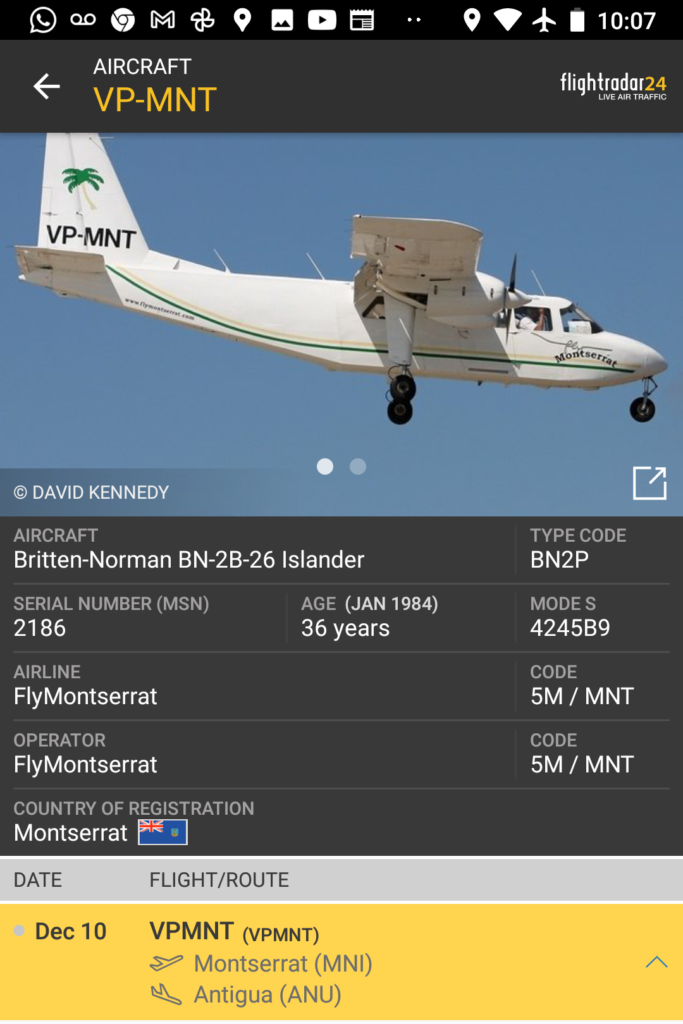
I knew LIAT had retrenched considerably during the pandemic and was operating only a limited service, but I never expected to see the entire fleet. Today all ten ATR aircraft were parked near the LIAT maintenance hangar at location 2, and as the photograph illustrates four aircraft clearly remain out of service having returned just recently from storage in Canada. A note of caution here, although I may have been just unlucky. I was approached by two airport officials when first looking through the perimeter fence and challenged as to what I was doing. My taxi driver who had parked across the road quickly intervened and explained that I was his guest and that I was not up to anything suspicious, after which I was allowed to both move about and take photographs freely through the fence. Be aware that the sun is directly in your eyes when taking photographs across the LIAT maintenance ramp before noon.
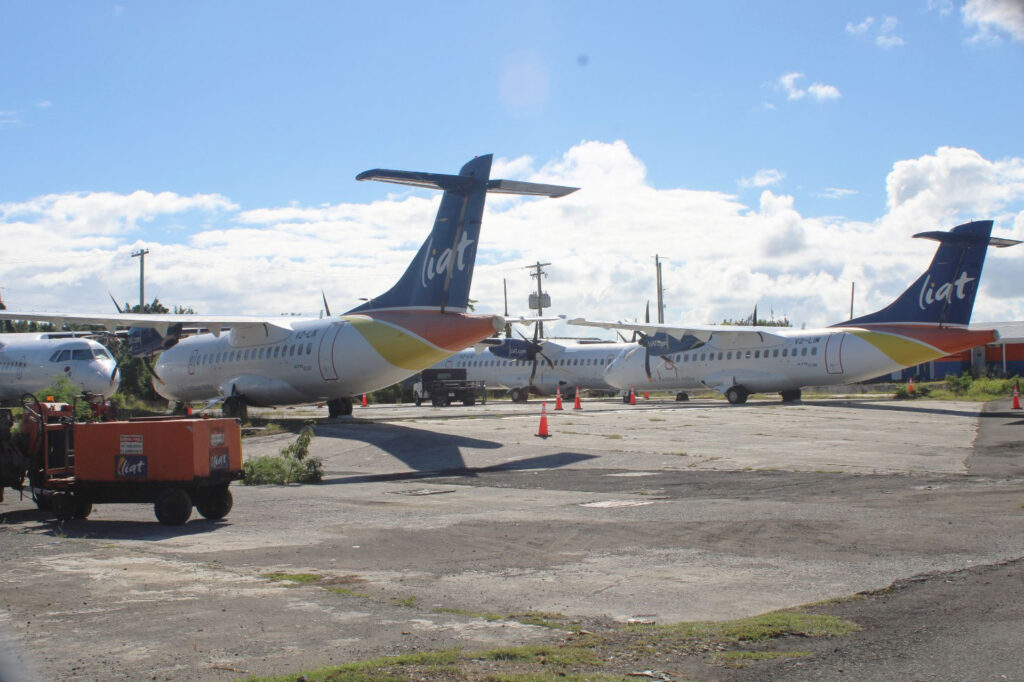
Stored LIAT ATR aircraft at Antigua.
From the LIAT hangar we continued clockwise along Burma Road and my next stop was planned for location 3 where I expected to find a good place for viewing westward along the runway with the Atlantic Ocean behind me. Alas this was not the case, the runway is higher than the coastal road and prevents this from a being an advantage point other than for shooting the under belly of departing aircraft. The view to my rear though was spectacular but not what I came for. On to the Biz-jet ramp next which is located on what remains of the former runway 10 to the south east corner of the airport, and is easily located by following Burma Road for a further half mile or so.
The new build hangars obstruct the view when looking from the coast but after Burma Road loops around Barnacle Point you are afforded an unimpeded view of the ramp through the perimeter fence from a westerly direction either side of location 4. Whether planned or not, the perimeter fence adjacent to runway 10 and the parked Biz-jets/Props is largely over grown with creeper like plants and on several occasions I had clear the foliage for photographic purposes. I’m not sure what prying eyes may have thought about the following suggestion, but a small ladder or box would have helped immensely with photographing aircraft parked on runway 10. Notwithstanding this natural deterrent I was impressed with the wide variety of aircraft on the ramp and hopefully the following photographs provide an example of what to expect most days. The Biz-jet ramp really is tucked away in this remote corner of the airport and cannot really be viewed thoroughly from any of the other locations highlighted on the map.
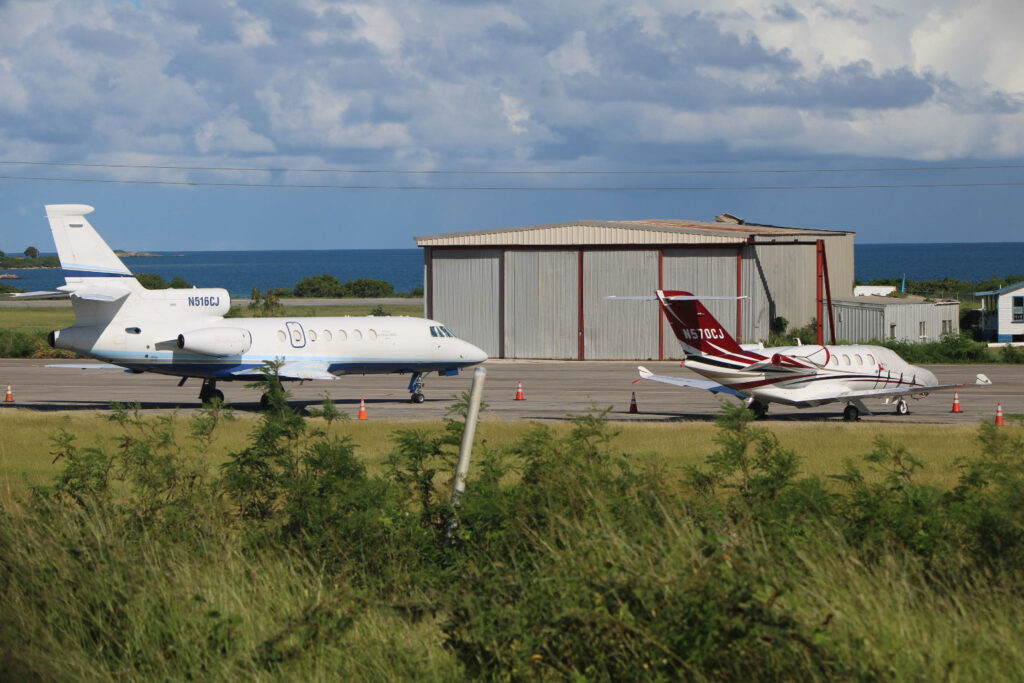
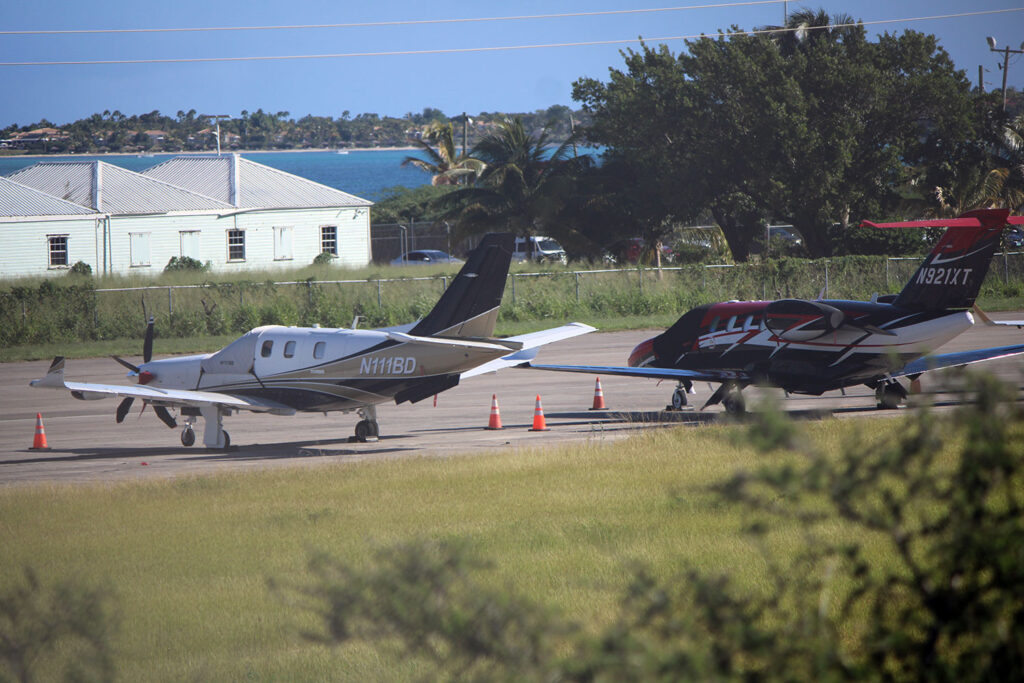
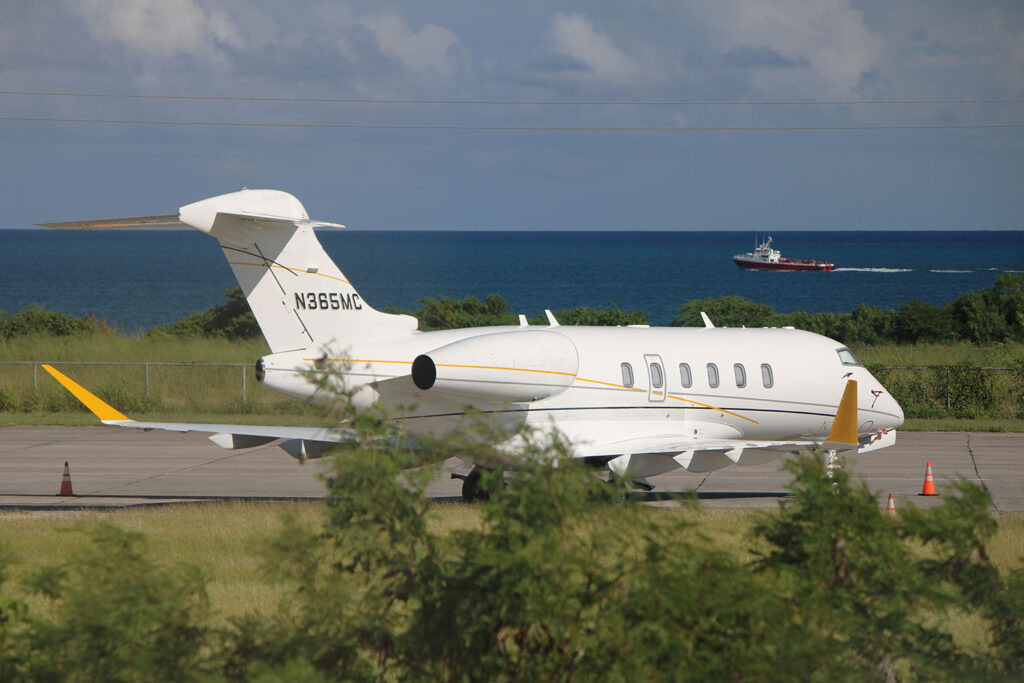
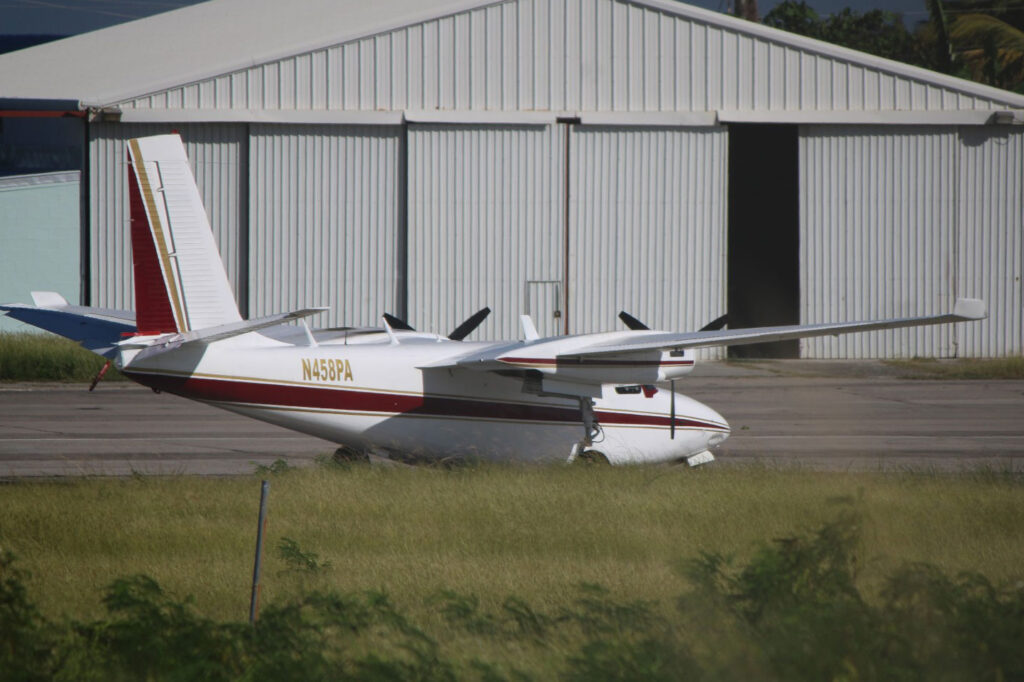
Moving westward along Burma Road there are numerous places either side of location 5 to stop and take photographs through the non-foliage covered perimeter fence across the runway towards the LIAT hangar and both terminals. Smaller parcel and passenger turbo props use the ramp in front of the old terminal on the left and anything accommodating more than 30 passengers will park in front of the new terminal to the right. Worth noting is that this section of Burma Road would provide excellent photographs of landing aircraft coming to a halt before exiting northwards on to the Terminal ramp or for departing aircraft tracking westwards up the runway towards location 1 for take-off. The sun is also behind you at this point right up to late afternoon. With zero aircraft movements during my visit you will have to take my word for it and settle for the photograph of several ATRs basking in front of the maintenance hangar, sorry. Whilst the map shows Burma Road proceeding merrily westwards from location 5 to join the main road at the western end of the main runway, do not be duped by this as there is a gully running across the road near to the quarry entrance that prevents passage in either direction at location 6.
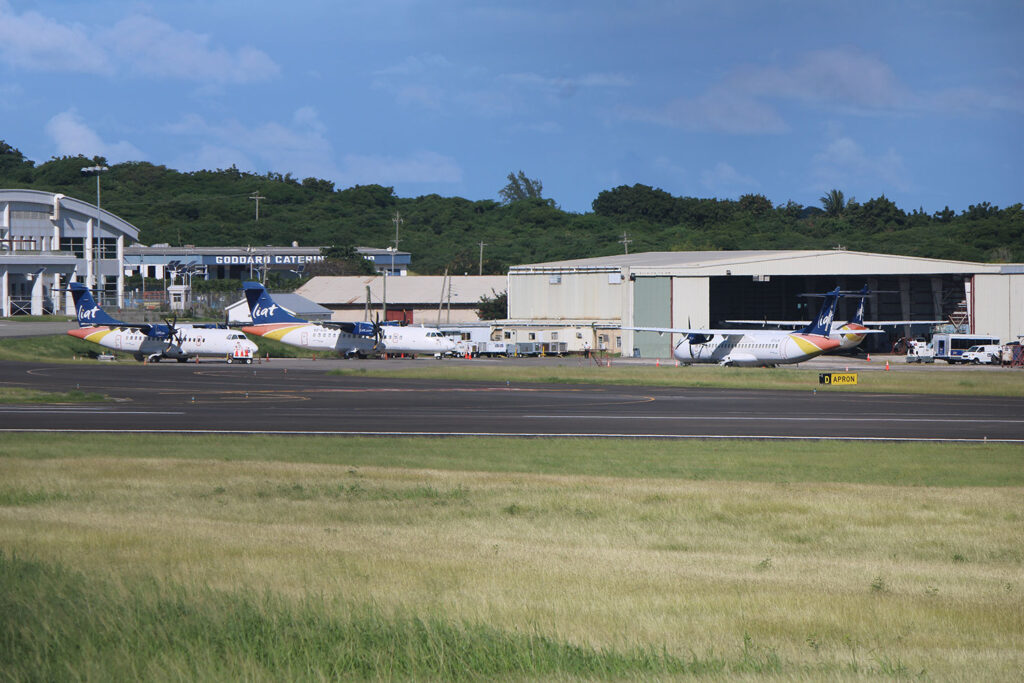
I returned to location 1 in an anti-clock wise direction along Burma Road and parked up on the small embankment to await the arrival of the Aircargo aircraft from Dominica. On time Cessna 208 N600TG appeared and dutifully landed adjacent to the viewing point, albeit closer to the end of the runway than anticipated. Location 1 really is a great advantage point to view landing aircraft and equally so for aircraft tracking up the runway when preparing for take-off. This section of my report would have been so much more impactful had the Amerijet Boeing 727-200 arrived on schedule, we all know how rare these night owls are to photograph in the open and it would have been a privilege to share it with you.
I found my 250mm telephoto lens more than adequate for the visit, although a 300mm may have helped at location 4 had I desired close up photographs of smaller aircraft parked in front of the hangers. Having surreptitiously dovetailed myself back in to my beach lounger at the resort LIAT ATR 500 V2-LID flew over on what appeared to be a test flight, it was most warming to see some movement at last from the LIAT fleet. Not long after the LIAT departure Beech C90 King Air N362MC graced us with a speedy exit southbound over the resort.
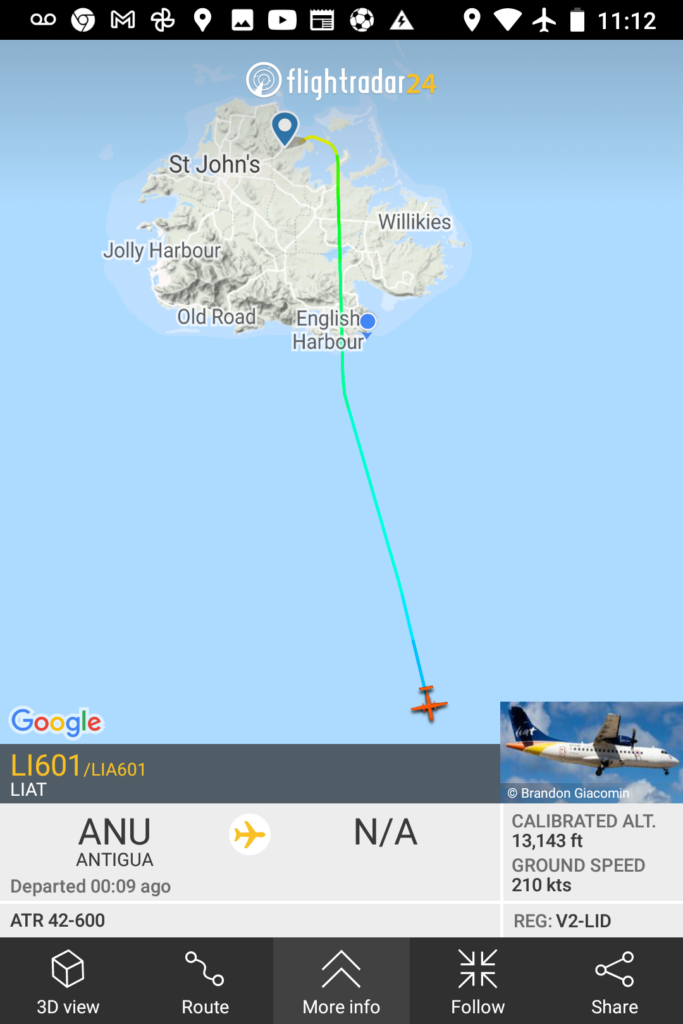
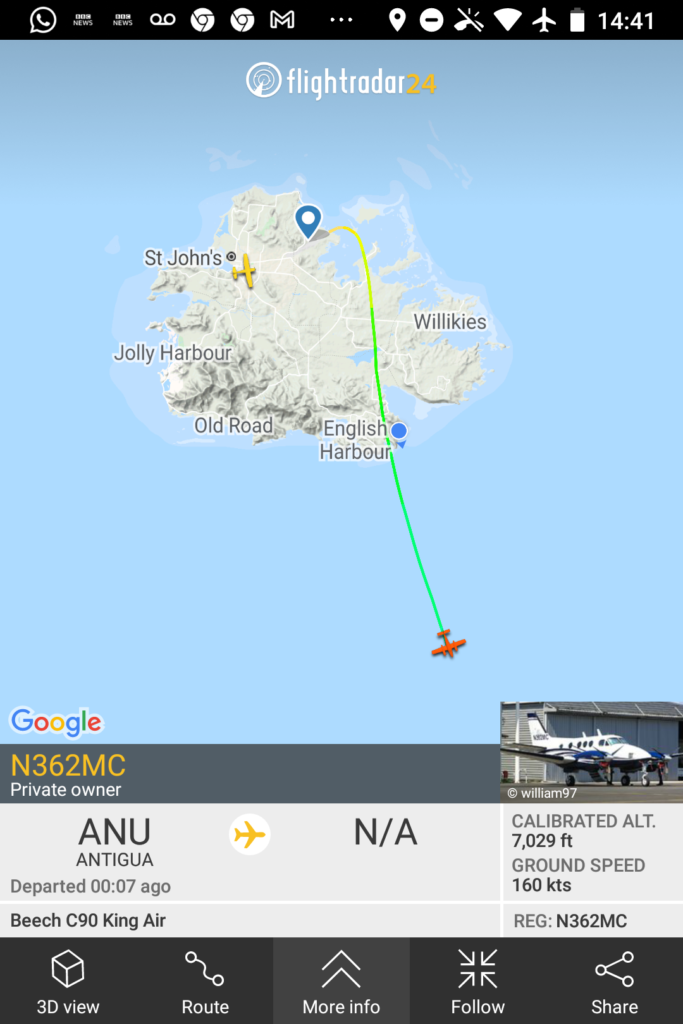
Day Four: 11.12.MMXX
And for a plane spotter what a day this turns out to be. Where do I start? Before joining the family on a boat excursion I decided to quickly check VC Bird International arrivals and noted that apart from a an increase in Biz-jet related activity ahead of the weekend nothing unusual for a weekday. For the first hour or so aboard the boat everything proceeded as expected with copious amounts of cocktails consumed to the background accompaniment of Bob Marley. That was until we turned around a headland and a private yacht (or was it a small battle cruiser?) came in to view, complete with helicopter preparing for take-off. The helicopter in question was in fact Andorran registered Airbus EC45 T7-NKA spotted yesterday at VC Bird International, but this time doing what it does best. I had been taking family photographs thus far on the boat and had no time to run to the camera bag for my telephoto lens. I appealed for the captain to slow down although he was more concerned with the fact that everyone had suddenly rushed starboard to witness the imminent helicopter departure, even my son joined them and begrudgingly stated that the event was most impressive. Later I tracked T7-NKA on Flightradar24 and established that it had performed the very short hop from the yacht to VC Bird International, probably on the daily caviar and bubbly replenishment run?
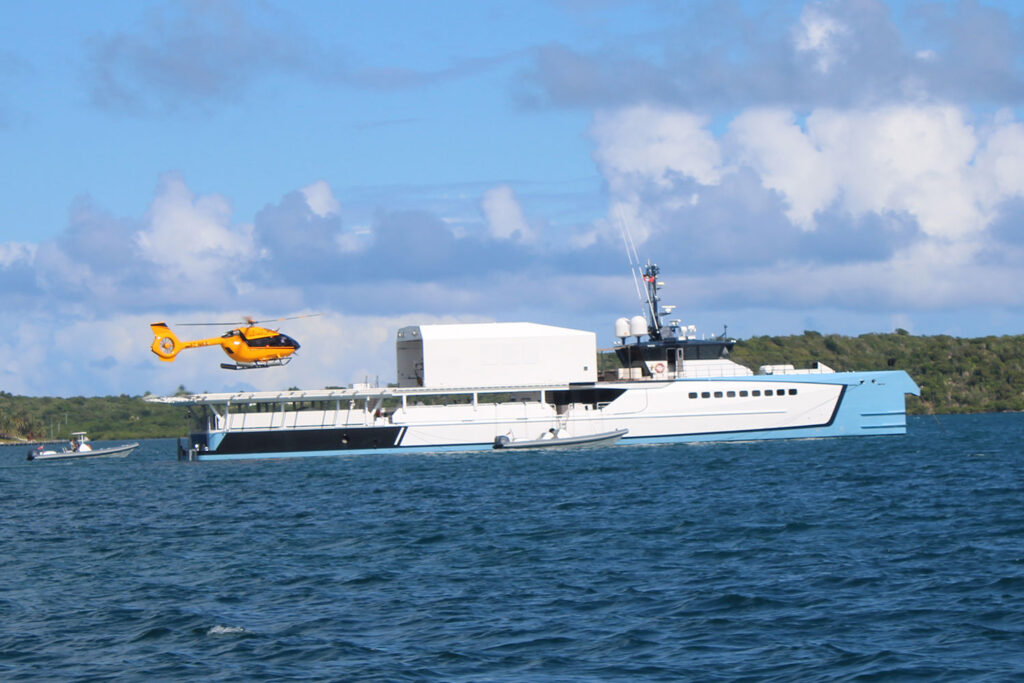
We returned to the resort and resumed doing the things one does at such places until the sound of jet engines attracted my attention, and just to the south west I noticed an Embraer 175 obviously heading for VC Bird International. Not only was this an unscheduled and most welcome arrival but after having run to the room for my phone Flightradar24 revealed that it belonged to United Express. Walking rather smugly to the beach I noticed a second identical aircraft drift in from the south at which point the confusion level began to mount. Back to the room and I traced these two aircraft to their point of origin earlier in the day and can confirm that they both had flown to Antigua from the Embraer factory at Sao Jose dos Campos via Manaus. Totally consumed by this “discovery” I began to check all flights heading north from Manaus and established that three additional Embraer 175 aircraft were close behind en-route to Antigua. Within just 70 minutes of the first aircraft arriving over Antigua, four additional company aircraft landed in succession at VC Bird International.
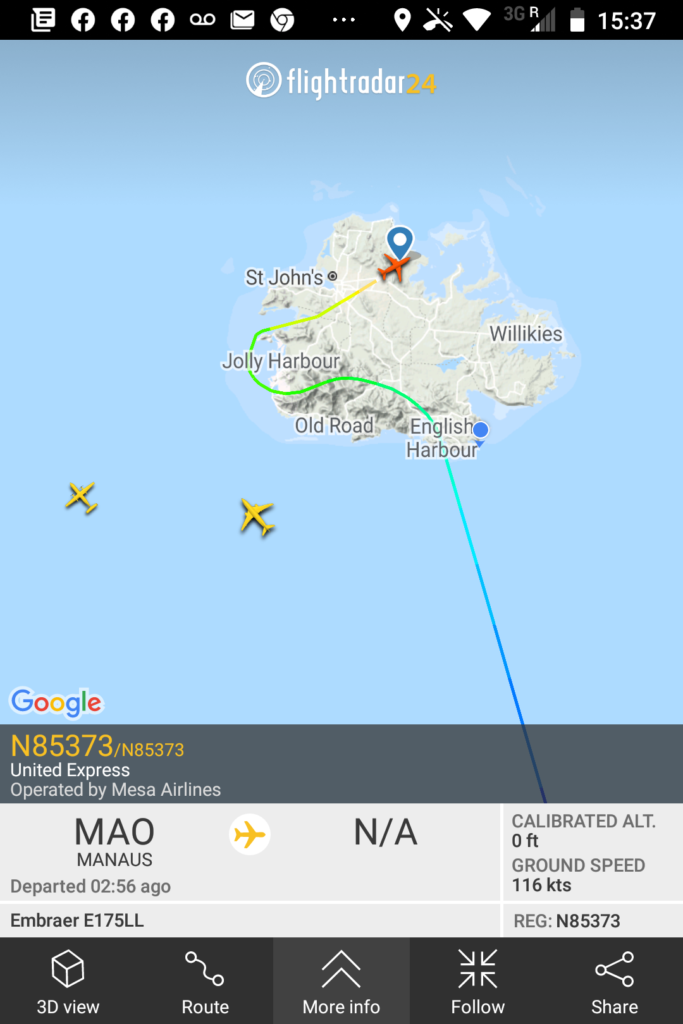
I did mention earlier that the island should afford good flyover spotting opportunities and here is an example of a typical caravan of small airliners skirting Antigua whilst on their southbound journeys at the end of the day. Air Antilles DHC-400 F-OMYS, Air Antilles ATR 73-600 F-OMYN and Air Caraibes ATR 72-600 are illustrated in the Flightradar24 image below.
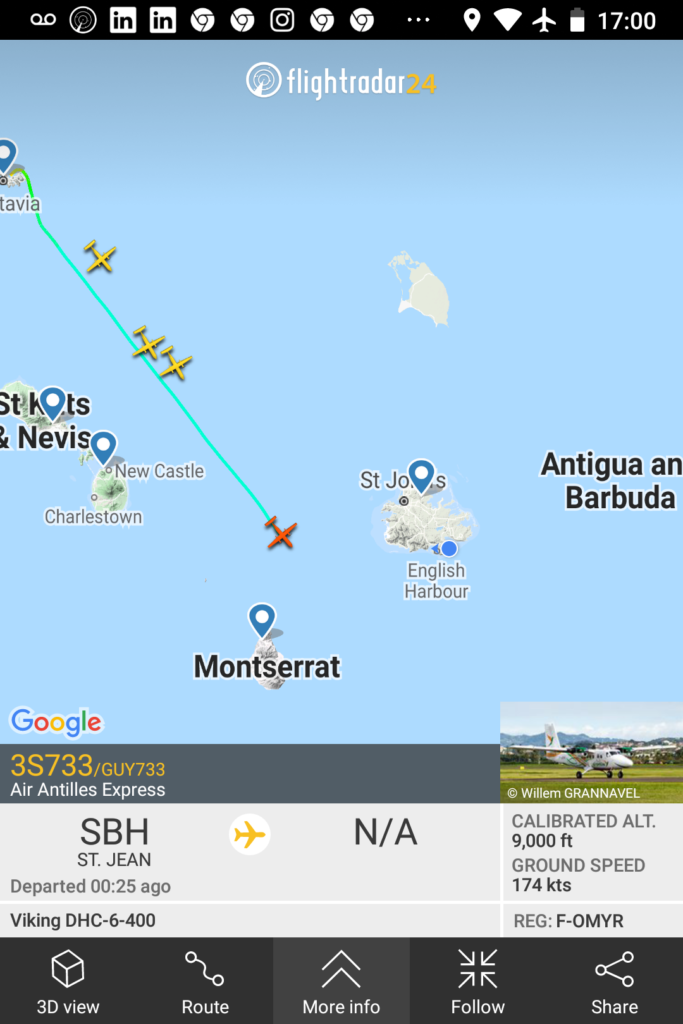
Day Five: 12.12.MMXX
Saturday is the busiest day for movements at VC Bird International and indeed all Caribbean airports, and in addition to the normal small turbo prop flights to neighbouring islands today’s movements would be boosted with a Sunwing Boeing 737-800 from Toronto, United Boeing 737-800 from New York, American Airlines Airbus aircraft from Miami, New York and Charlotte and lastly from the USA a Delta Boeing 737-800. From London BA despatched two 777s (one via Bassette), and Virgin a single Boeing 787-9 via Barbados. An early non-scheduled arrival that I failed to spot was Embraer 145 HI1052 from Santo Domingo, however I did spot the Air Transport International Boeing 757-200 Combi N751CX that passed the resort arriving from Cocoa Beach. This aircraft is one of only two civilian Combi versions of the Boeing 757 in service, you can see the cabin windows at the rear of the aircraft in the below image where ATI have installed 42 seats for mixed cargo/ passenger operations.
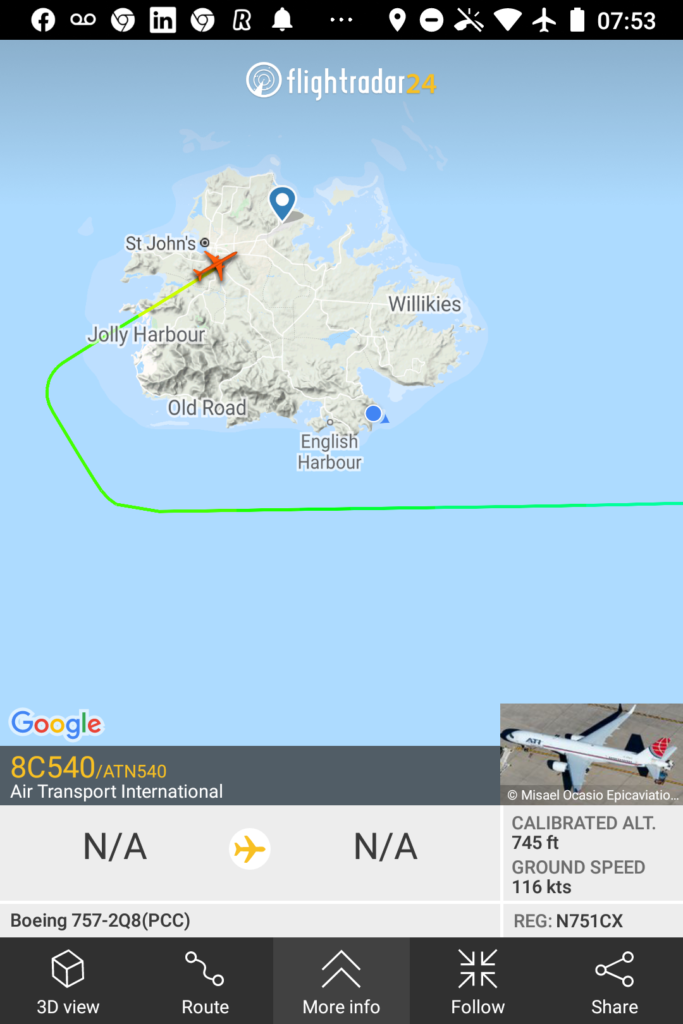
A sixth United Embraer 175 N85374 sneaked into the airport without me noticing but nobody in the resort failed to miss the departing Caribbean Airlines Boeing 737-800 9Y-JMC sprightly climbing out en route to Barbados.
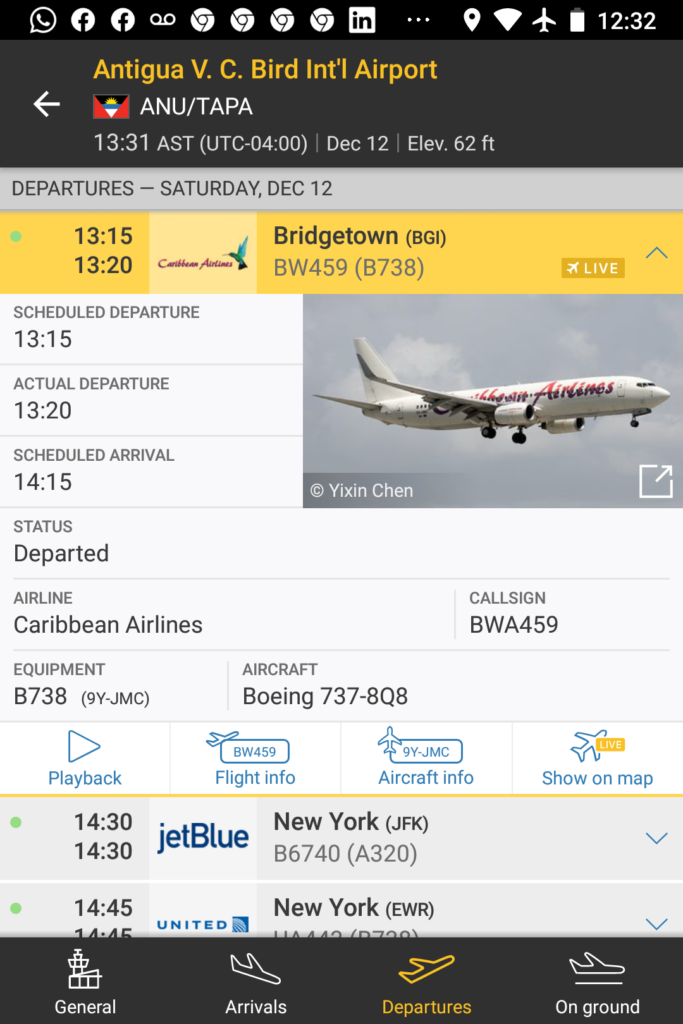
A little research that evening established that the five United Airlines Embraer 175 aircraft that landed yesterday departed for Houston via Fort Lauderdale where they are destined to join Mesa Airlines as part of the United Express operation. I can think of worse places to night stop on a delivery flight and I wonder if Antigua is favoured by US airlines when taking delivery of Embraer aircraft? The aircraft have since been pressed into service upon arriving at Houston and you can find images of these splendid new aircraft at various US locations on the United Express schedule.
Appearing today and indeed only once during my visit was the rather fine Anguilla Air Services BN Trislander VP-AJR, one of only a very small number of passenger variants of this wonderful British airliner still in service. Last spot of the day and lighting up the sky from the south was Amerijet Boeing 767-200 N743AX in bound from Kingston, Jamaica.
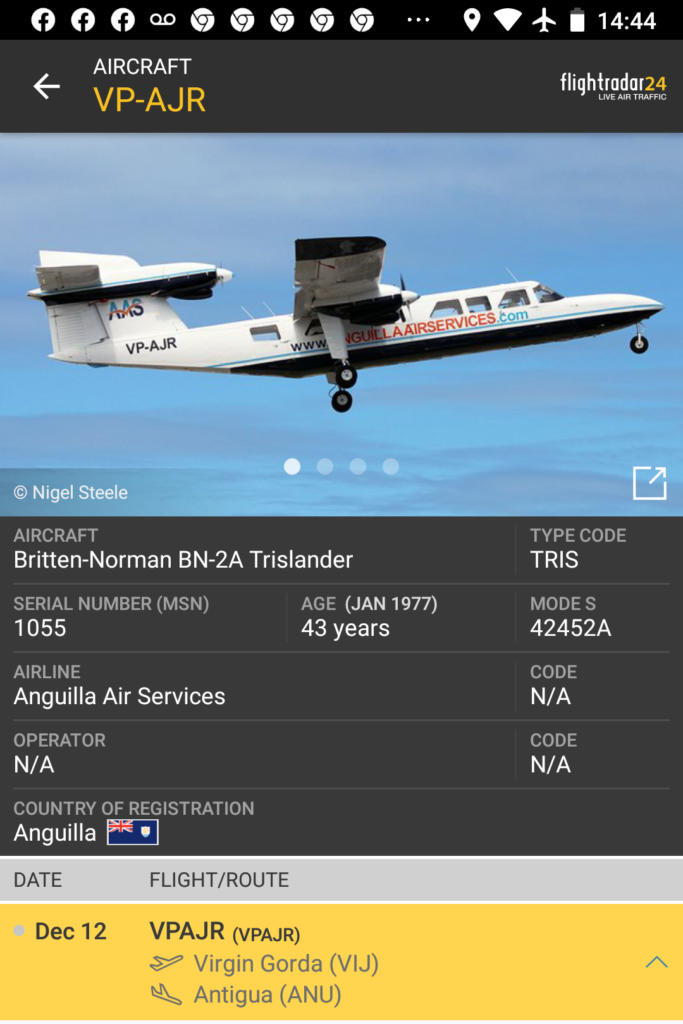
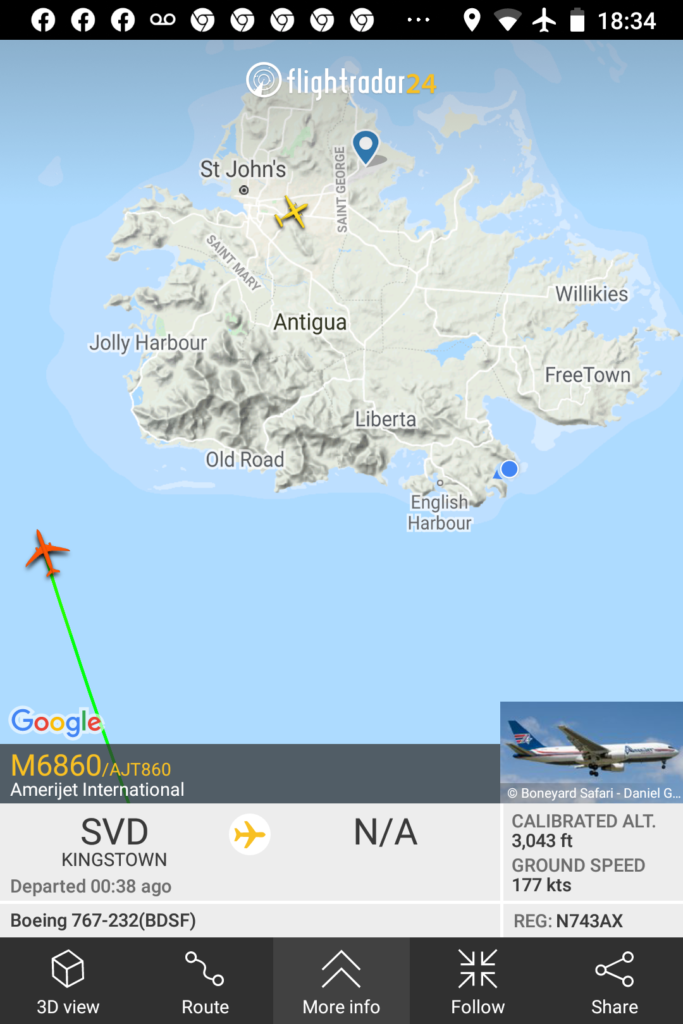
Day Six: 13.12.MMXX
The airport arrivals board looked fairly normal compared to yesterday except for an Air Canada A320 schedule from Montreal. Afternoon aircraft over the resort included Winair DHC-6 300 Twin Otter PJ-WIU en route to Dominca, with arrivals including BA 777 G-VIIT from London Gatwick and St Barth Commuter DHC-6 Twin Otter F-OSBC from Point-A-Pitre.
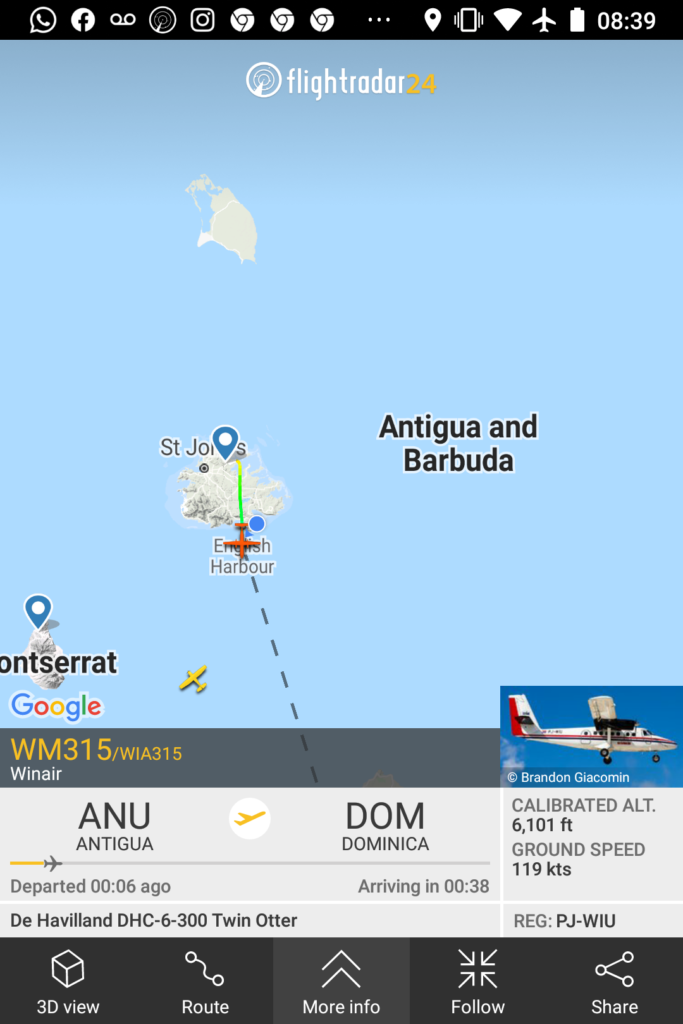
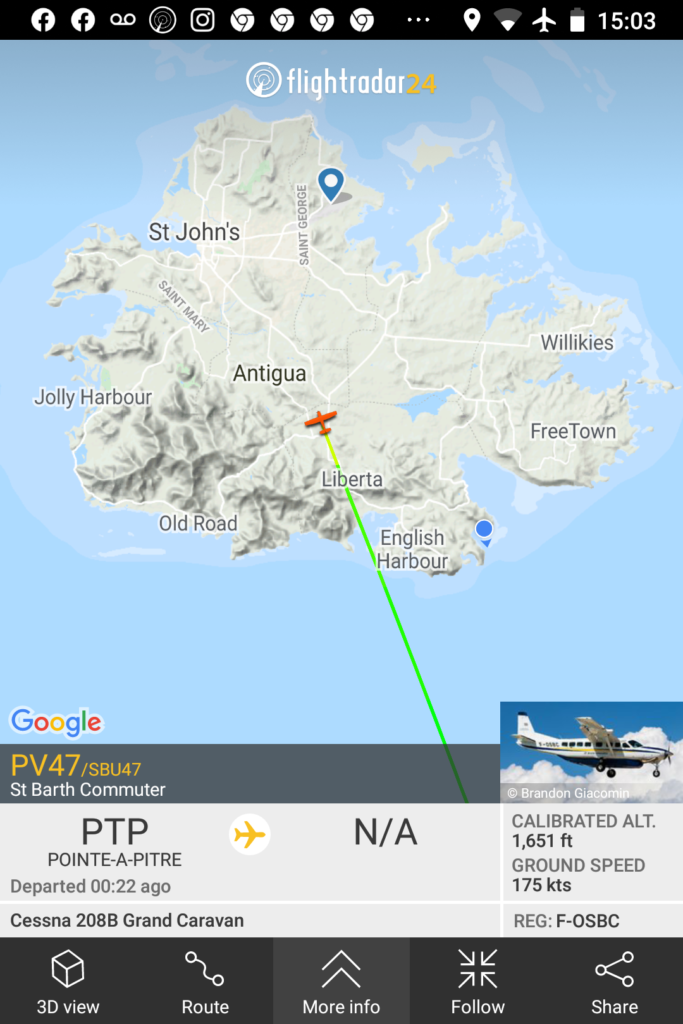
Day Seven: 14.12.MMXX
With the weekend arrivals “frenzy” over, todays movements have resumed the daily average of ten flights and nothing much to report other than I spotted LIAT ATR 42-600 V2-LID on a scheduled return flight to Castries, this being the same aircraft spotted earlier in the holiday conducting test flights around the island. Just before sunset a clutch of southbound overflights revealed themselves and of interest it included an Air Antilles Express DHC-6 400 Twin Otter F-OMYR and company ATR 42-500 F-OIXH.
Day Eight: 15.12.MMXX
For me today revealed the most interesting and exciting aircraft of the holiday. Having returned to my room after breakfast I thought best to check what might over fly Antigua in the next hour or so. With the aid of Flightradar24 I spotted a yellow coloured four engine aircraft heading south and thought it most likely to be an Airbus A340-300 or cargo Boeing 747-400, that was of course until I highlighted the aircraft. To my complete astonishment the now red image revealed itself to be Douglas DC-8-73CF OB-2059-P of Skybus Jet Cargo Peru. Having almost dropped my phone I managed to regain my senses and feverishly started to plot the aircraft’s trajectory in the hope that it would fly within spotting range of Antigua. Here I am sitting on the balcony of my room looking west hoping, wanting, willing this one of only perhaps nine serviceable DC-8-70 series aircraft to come into view. Unfortunately, the aircraft passed to the west of Monserrat and no end of cloud covered horizon searching could reveal the aircraft.

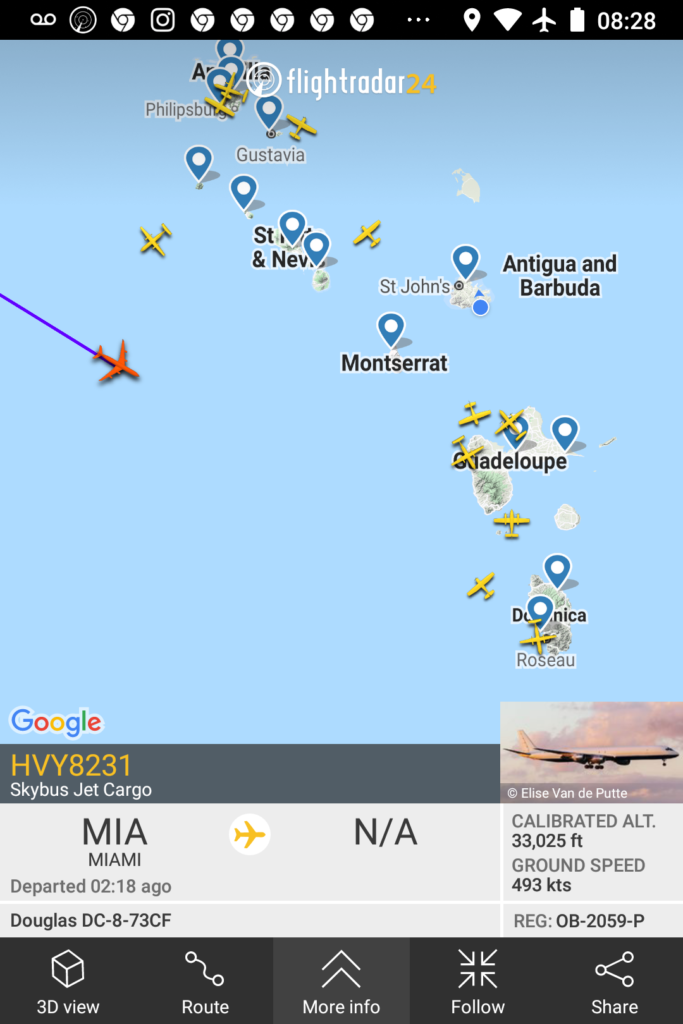
The aircraft proceeded on to Barbados and returned to Miami later in the day, sadly again routing to the west of Monserrat and out of view. A quick Internet search confirms that this aircraft was only taken out of storage by Skybus Jet Cargo last August. This was most certainly the one that got away, but at least we know that one more of these magnificent 1960s jet liners has returned to service. More importantly to all us spotters is the fact that it frequents Miami and that means we stand a chance of spotting this aircraft perhaps next year on our travels. I have racked my brains but I cannot be sure when I last spotted a DC-8 in commercial service.
Day Nine: 16.12.MMXX – home a day earlier than scheduled
I mentioned earlier in this report that there were four flight changes prior to departure, hinting perhaps that we hadn’t yet finished with flight alterations on this trip. Well you guessed correctly, as upon arrival into Antigua we learnt that our return flight would no longer be direct and was now re-scheduled for the 16th December and via Barbados. Not ideal as I prefer overnight flights to be direct but from a positive point of view it would provide another opportunity to possibly spot something unusual at Barbados albeit after dark.
Like the last day on most holidays, mine was spent largely packing and playing at being a family man with little in the way of plane spotting achieved. The usual suspects came and went from Antigua including Ameriflight Beech C99 Airliner N204AF from San Juan, so I was most surprised when we left the stand at 21:00 on board G-VNEW to taxi past an additional two Amerifleet Beach C99 Airliners N4199C and N228BH each surrounded by employees loading last minute parcels before departure to San Juan. The last time I spotted more than one Beech B99 Airliner on the ground was at Buffalo Airport in the mid-1970s when I made many bicycle journeys across the border from my uncle’s house in Canada to log all types of Allegheny aircraft of that era. Tonight the pair of Beech C99s Airliners were the only aircraft on the ramp and were a fitting end to my all too short a stay in Antigua. The flight from Antigua to Barbados was virtually a rerun of the inbound flight on the 7th December but this time we had slightly more passengers and the official manifest stated 178 passengers, leaving just 68 additional passengers to board the aircraft at Barbados. As usual we landed from the west and turned on the northern ramp and parked in the same position as before.
Seated on the starboard side of the aircraft I was unable to clearly see the aircraft parked on the ramp as we decelerated along the runway; this would have to wait for the long taxi later from the terminal to the end of the runway for take-off. Not expecting any aircraft to be parked to the right of our aircraft I glanced out of the window and to my astonishment the former BA/Comair Boeing 737-400 had been replaced with an Ilyushin Il-76 TD RA-76952 of Volga-Dnepr Airlines. My family informs me that for the entire 80 minute stopover in Barbados I gaped longingly through the window at this most majestic aircraft. I tried every trick in the book to take a photograph but it proved impossible due to the combination of interior and exterior lighting casting unwanted reflections of my face, camera and unwanted boarding passengers on the large cabin window. I have never seen an Il-76 this close up before so it was a real treat to say the least, a moment unfortunately lost on the remainder of the group. The more modern looking Perm turbofan engines were very evident on this relatively new and updated model of the venerable aircraft. It transpires that it had been on the ramp since December 11th and only departed Barbados on 22nd December for the journey back across the Atlantic Ocean.
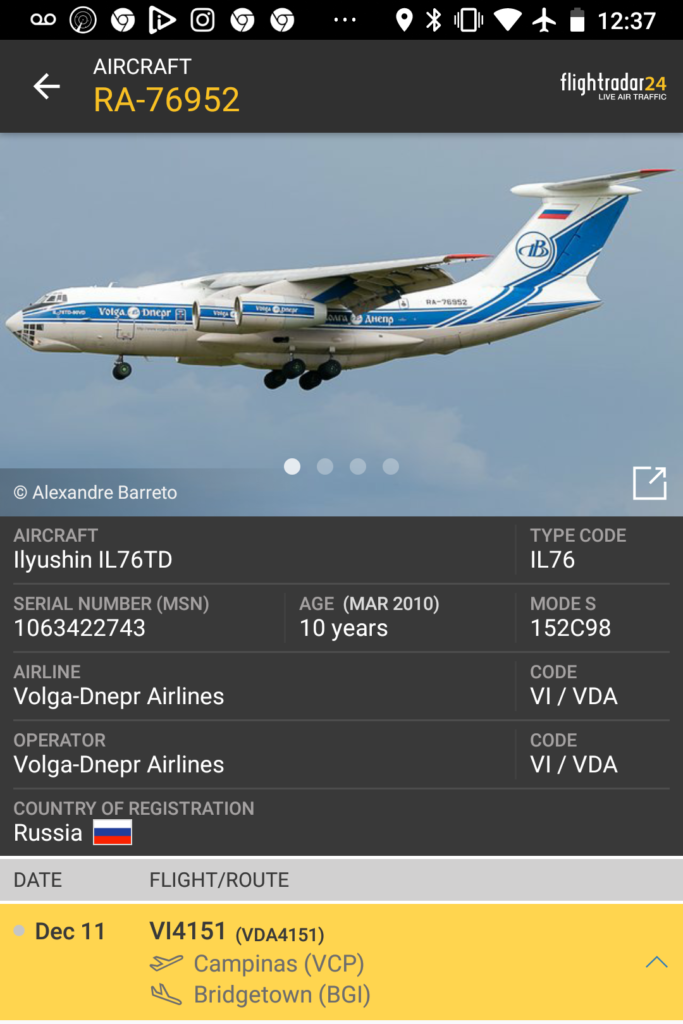
Boarding completed, G-VNEW taxied west along the ramp and afforded good close up views of Global 5500 HB-JRJ, Cessna S550 YV-3310, CL 605 M-RLIV, Falcon 900 G-MRLB and DHL Boeing 757 HP-2110. The final aircraft spotted on my short Caribbean holiday were the pair of RSS Fairchild C26A Metro IIIs as we accelerated past their illuminated hangars during our take-off run. After rotation I settled back into my seat for the 8 hour journey home to London and reflected upon the various bite sized portions of plane spotting I had manged to fit into the family Caribbean holiday.
Let’s start with my single biggest mistake of the holiday, selecting Thursday not Saturday to visit VC Bird International. With the news that the holiday had been shortened I felt obliged not to make the airport visit a full day so I decided to trade volume for a single “special” aircraft which in fact turned out to be a no show. Had I chosen Saturday afternoon for my half day visit I would most likely have taken so many photographs I may well have run out of storage space shooting not only the US holiday arrivals but in particular the five United Express Embraer 175 aircraft departing for Fort Lauderdale on the next leg of their marathon delivery flight from Brazil to Houston. What I have learnt from this is to expect the unexpected in the Caribbean when plane spotting, but isn’t that why we do what we do and I just got a little unlucky?
What I did enjoy immensely about VC Bird International was the opportunity to spot airliners as small as the Cessna 414 and BN Islander right through to the large Boeing and Airbus twin jet family of airliners at what is a modestly sized airport. Antigua is not unique in this respect as most of the larger Caribbean islands mirror each other so you can expect a similar spotting experience should you select somewhere different to Antigua for a holiday. During my nine day holiday VC Bird International was host to the following eclectic list of airliners.
| Small Airliners | Large Airliners |
| ATR
42 & 72 |
Airbus
A320, A321 & A330-300 |
| Beech
B99, C99 & B1900 |
Boeing
757, 737-400/800/900, B777-200 & B787-9 |
| Cessna
414 Chancellor & C208 (incl. float version) |
Embraer
175 |
| Britten Norman
Islander & Trislander |
Ilyushin
IL76 TD |
| DHC
Twin Otter |
|
| Embraer
120 Brasilia & 145 |
|
| Fairchild
Metro III & C26A |
|
| Pilatus
PC-12 |
|
| Shorts
SD-360 |
Let us not forget overflights, including the sorely missed Skybus Jet Cargo Douglas DC-8-73CF. The Conviasa Airbus A340-200 was also a no-show as it appeared to be passing through Moscow, Belgrade and Tehran during my visit to Antigua. The short stay enabled me to remove a number of smaller airliner types from my spotting Challenge so that was job well done. The holiday also enabled me to add a new aircraft type to my flight list, the Boeing 787-9 which I sampled four times. Disappointingly after such a long wait I found the aircraft a little underwhelming to be honest.
What did stand out for me at VC Bird International was seeing airliners such as the BN Islander, BN Trislander and DHC-6 Twin Otter still carrying passengers in the very environment they were designed to fly in over five decades ago. It was 29 years ago this week between Christmas Day and New Year that I took a flight aboard a BN Islander, and that too included a short hop over water to a neighbouring island. It was aboard a Loganair BN Islander from Wick to Kirkwall and had we needed to ditch that day in the Scapa Flow I fear the water temperature would have been markedly different from that found around Antigua.
Planning a holiday to Antigua and or Barbados? I think it is fair to say that one can add a splash of spotting to a holiday in either of these two locations, but not perhaps a splash of holiday to a spotting trip. What I am convinced of, however, is that one can add a holiday to a spotting trip to San Juan, which as we all know is the jewel in the Caribbean aviation crown without doubt. Mrs M has already mentioned that she plans to revisit the resort in Antigua next December for a longer stay this time. If so, this will certainly allow for an overnight visit to San Juan and some very tasty spotting. My only visit to San Juan was in 2000 on a business trip and I logged more than 25 piston engine airliners. It would be fantastic to have the opportunity to revisit the airport some 20 years later.
All the best for 2021 and start planning those spotting trips.
I would never have managed to go to Antigua if it had not been for the extraordinary efforts made by Tim at DialAFlight Concierge. With the frequent cancellations made by the airlines and hotels, changing COVID restrictions etc he never gave up and successfully navigated us through the many challenges encountered along the way.





5 comments
John, a superb read, made me chuckle at the possibility of “turning” the daughters boyfriend……but its better to be on your own I feel, no daft questions to answer, and no incorrect loggings…….my wife does that on purpose I’m sure. Hope Cpt Morgan was as friendly to you as he is to me.
I ‘ve tried the 787 and 350 myself, both on the HEL-NRT run. Much prefer the 787….or is it JAL…..their in flight service I founf superb, even though I was at the back in the cheap seats!!!!
I’m now wondering if I want to visit Antigua myself!!!!
Thanks for your kind words John, much appreciated. I can assure you that Captain Morgan was a superb host. Happy to discuss Antigua as a holiday destination if you want.
John Madden
Great report
I think the Beech 99 in BGI is 8P-DCA though
Thanks, I enjoyed writing it.
Checked my notes made on location and you are correct regarding the B99 registration. My mistake.
John
Great article! Can’t wait for the rest of the series!